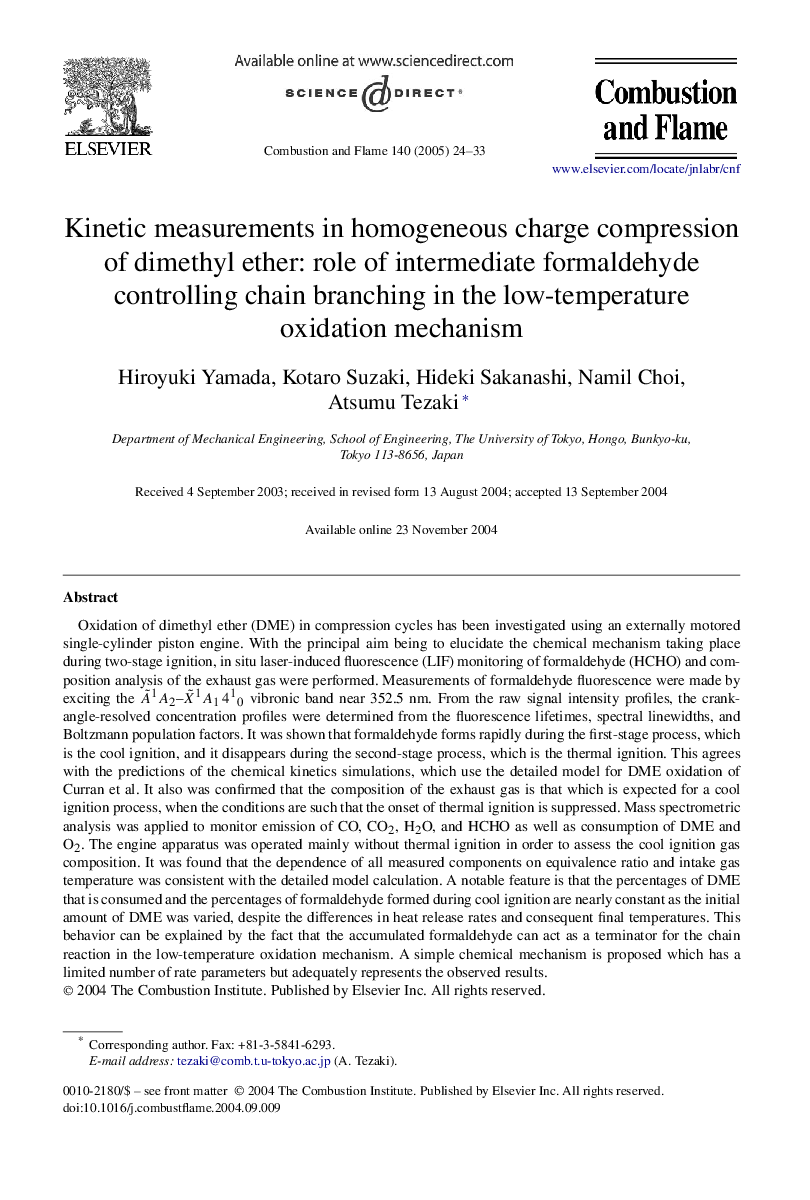| کد مقاله | کد نشریه | سال انتشار | مقاله انگلیسی | نسخه تمام متن |
|---|---|---|---|---|
| 9624544 | 458065 | 2005 | 10 صفحه PDF | دانلود رایگان |
عنوان انگلیسی مقاله ISI
Kinetic measurements in homogeneous charge compression of dimethyl ether: role of intermediate formaldehyde controlling chain branching in the low-temperature oxidation mechanism
دانلود مقاله + سفارش ترجمه
دانلود مقاله ISI انگلیسی
رایگان برای ایرانیان
کلمات کلیدی
موضوعات مرتبط
مهندسی و علوم پایه
مهندسی شیمی
مهندسی شیمی (عمومی)
پیش نمایش صفحه اول مقاله

چکیده انگلیسی
Oxidation of dimethyl ether (DME) in compression cycles has been investigated using an externally motored single-cylinder piston engine. With the principal aim being to elucidate the chemical mechanism taking place during two-stage ignition, in situ laser-induced fluorescence (LIF) monitoring of formaldehyde (HCHO) and composition analysis of the exhaust gas were performed. Measurements of formaldehyde fluorescence were made by exciting the AË1A2-XË1A1410 vibronic band near 352.5 nm. From the raw signal intensity profiles, the crank-angle-resolved concentration profiles were determined from the fluorescence lifetimes, spectral linewidths, and Boltzmann population factors. It was shown that formaldehyde forms rapidly during the first-stage process, which is the cool ignition, and it disappears during the second-stage process, which is the thermal ignition. This agrees with the predictions of the chemical kinetics simulations, which use the detailed model for DME oxidation of Curran et al. It also was confirmed that the composition of the exhaust gas is that which is expected for a cool ignition process, when the conditions are such that the onset of thermal ignition is suppressed. Mass spectrometric analysis was applied to monitor emission of CO, CO2, H2O, and HCHO as well as consumption of DME and O2. The engine apparatus was operated mainly without thermal ignition in order to assess the cool ignition gas composition. It was found that the dependence of all measured components on equivalence ratio and intake gas temperature was consistent with the detailed model calculation. A notable feature is that the percentages of DME that is consumed and the percentages of formaldehyde formed during cool ignition are nearly constant as the initial amount of DME was varied, despite the differences in heat release rates and consequent final temperatures. This behavior can be explained by the fact that the accumulated formaldehyde can act as a terminator for the chain reaction in the low-temperature oxidation mechanism. A simple chemical mechanism is proposed which has a limited number of rate parameters but adequately represents the observed results.
ناشر
Database: Elsevier - ScienceDirect (ساینس دایرکت)
Journal: Combustion and Flame - Volume 140, Issues 1â2, January 2005, Pages 24-33
Journal: Combustion and Flame - Volume 140, Issues 1â2, January 2005, Pages 24-33
نویسندگان
Hiroyuki Yamada, Kotaro Suzaki, Hideki Sakanashi, Namil Choi, Atsumu Tezaki,